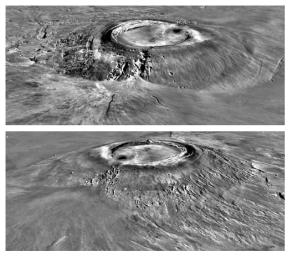- Arsia Mons
MarsGeo-Mount
name = Arsia Mons

195px|Image Credit: NASA/MOLA Science Team
latitude=9.5
N_or_S=S
longitude=120.5
E_or_W=W
peak = 16 km
discoverer =
eponym = Latin - "Arsia Silva" - classical albedo feature nameArsia Mons is the southernmost of three
volcano s (collectively known asTharsis Montes ) on theTharsis bulge near theequator of theplanet Mars. To its north isPavonis Mons , and north of that isAscraeus Mons . The tallest mountain in thesolar system ,Olympus Mons , is to its northwest. Its name comes from a correspondingalbedo feature on a map byGiovanni Schiaparelli , which he named in turn after the legendary Roman forest ofArsia Silva .Arsia Mons is 270 miles (approximately 435 kilometres) in diameter, almost 12 miles high (more than 9 kilometers (5.6 miles) higher than the surrounding plains [ [http://photojournal.jpl.nasa.gov/catalog/PIA02337 Catalog Page for PIA02337 ] ] ), and the summit
caldera is 72 miles (approximately 110 km) wide. [ [http://photojournal.jpl.nasa.gov/catalog/PIA03948 Catalog Page for PIA03948 ] ] It experiences atmospheric pressure lower than 107 pascals [http://www-star.stanford.edu/projects/mgs/sum/s0401131906.html Martian Weather Observation] NASA MGS data 9.2 degrees S 238.2 degrees E 17757 meters 1.07 mbar] at the summit. Except for Olympus Mons, it is the biggest volcano in volume.A repeated weather phenomenon occurs each year near the start of southern winter over Arsia Mons. Just before southern winter begins, sunlight warms the air on the slopes of the volcano. This air rises, bringing small amounts of dust with it. Eventually the rising air converges over the volcano's caldera and the fine
sediment blown up from the volcano's slopes coalesces into a spiraling cloud of dust that is thick enough to observe from orbit. The spiral dust cloud over Arsia Mons repeats each year, but observations and computer calculations indicate it can only form during a short period of time each year. Similar spiral clouds have not been seen over the other large Tharsis volcanoes, but other types of clouds have been seen. The spiral dust cloud over Arsia Mons can tower 15 to 30 kilometers (9 to 19 miles) above the volcano. [ [http://photojournal.jpl.nasa.gov/catalog/PIA04294 Catalog Page for PIA04294 ] ]The caldera of Arsia Mons was formed when the mountain collapsed in on itself after its reservoir of
magma was exhausted. There are many other geologic collapse features on the mountain's flanks. [ [http://photojournal.jpl.nasa.gov/catalog/PIA03799 Catalog Page for PIA03799 ] ]Possible cave entrances
As of 2007 seven putative cave entrances have been identified in satellite imagery of the flanks of Arsia Mons. [" [http://www.lpi.usra.edu/meetings/lpsc2007/pdf/1371.pdf Themis Observes Possible Cave Skylights on Mars] ." G. E. Cushing, T. N. Titus, J. J. Wynne, P. R. Christensen. Lunar and Planetary Science XXXVIII (2007)] [cite web| url=http://www.planetary.org/blog/article/00000984/| publisher=The Planetary Society Weblog| first= Emily| last= Lakdawalla| title=Windows onto the abyss: cave skylights on Mars| date=2007-05-23| accessdate=2007-05-26] They have been informally dubbed Dena, Chloë, Wendy, Annie, Abbey, Nikki, and Jeanne and resemble "skylights" formed by the collapse of cave ceilings.
*Dena (coord|-6.084|N|239.061|E|globe:Mars)
*Chloë (coord|-4.296|N|239.193|E|globe:Mars)
*Wendy (coord|-8.099|N|240.242|E|globe:Mars)
*Annie (coord|-6.267|N|240.005|E|globe:Mars)
*Abbey and Nikki (coord|-8.498|N|240.349|E|globe:Mars)
*Jeanne (coord|-5.636|N|241.259|E|globe:Mars)From day to night, temperatures of the circular features change only about one-third as much as the change in temperature of surrounding ground. While this is more variable than large caves on Earth, it is consistent with them being deep pits. However, due to the extreme altitude, it is unlikely that they will be able to harbour any form of Martian life. [cite web|url=http://www.jpl.nasa.gov/news/news.cfm?release=2007-106|title=NASA Orbiter Finds Possible Cave Skylights on Mars|accessdate=2007-09-22|publisher=
Jet Propulsion Laboratory ]A more recent photograph of one of the features shows sunlight illuminating a side wall, suggesting that it may simply be a vertical pit rather than an entrance to a larger underground space. [cite news|url=http://space.newscientist.com/article/dn12566-strange-martian-feature-not-a-bottomless-cave-after-all.html| title=Strange Martian feature not a 'bottomless' cave after all|date= 2007-08-30|publisher=NewScientist.com news service| first=David|last=Shiga] Nonetheless, the darkness of this feature implies that it must be at least 78 metres deep.
References
External links
* [http://ic.arc.nasa.gov/ic/projects/bayes-group/Atlas/Mars/features/a/arsia_mons.html NASA/Ames Mars Atlas: Feature entry for Arsia Mons]
* [http://apod.nasa.gov/apod/ap070528.html A Hole in Mars] -Astronomy Picture of the Day for28 May 2007
Wikimedia Foundation. 2010.
